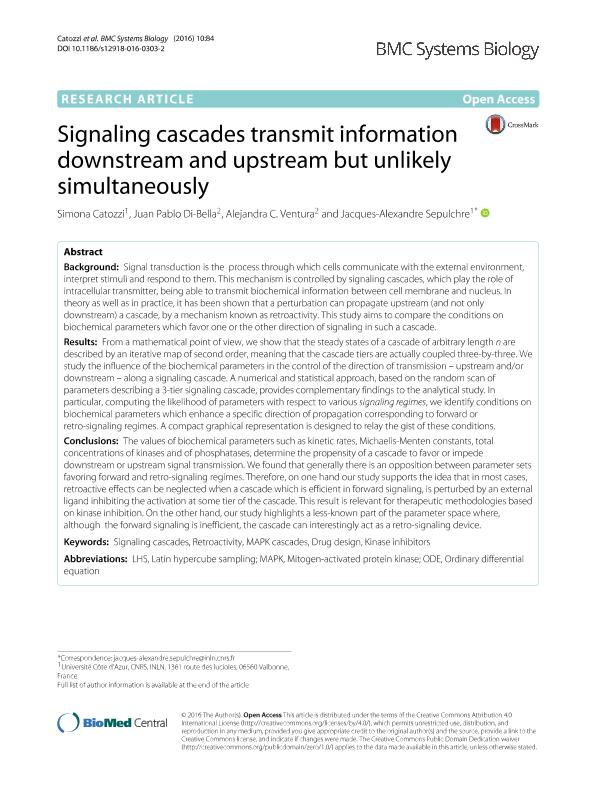Mostrar el registro sencillo del ítem
dc.contributor.author
Catozzi, Simona
dc.contributor.author
Di Bella, Juan Pablo

dc.contributor.author
Ventura, Alejandra

dc.contributor.author
Sepulchre, Jacques Alexandre

dc.date.available
2018-10-01T19:34:46Z
dc.date.issued
2016-08
dc.identifier.citation
Catozzi, Simona; Di Bella, Juan Pablo; Ventura, Alejandra; Sepulchre, Jacques Alexandre; Signaling cascades transmit information downstream and upstream but unlikely simultaneously; BioMed Central; Bmc Systems Biology; 10; 1; 8-2016; 1-20
dc.identifier.issn
1752-0509
dc.identifier.uri
http://hdl.handle.net/11336/61428
dc.description.abstract
Background: Signal transduction is the process through which cells communicate with the external environment, interpret stimuli and respond to them. This mechanism is controlled by signaling cascades, which play the role of intracellular transmitter, being able to transmit biochemical information between cell membrane and nucleus. In theory as well as in practice, it has been shown that a perturbation can propagate upstream (and not only downstream) a cascade, by a mechanism known as retroactivity. This study aims to compare the conditions on biochemical parameters which favor one or the other direction of signaling in such a cascade. Results: From a mathematical point of view, we show that the steady states of a cascade of arbitrary length n are described by an iterative map of second order, meaning that the cascade tiers are actually coupled three-by-three. We study the influence of the biochemical parameters in the control of the direction of transmission - upstream and/or downstream - along a signaling cascade. A numerical and statistical approach, based on the random scan of parameters describing a 3-tier signaling cascade, provides complementary findings to the analytical study. In particular, computing the likelihood of parameters with respect to various signaling regimes, we identify conditions on biochemical parameters which enhance a specific direction of propagation corresponding to forward or retro-signaling regimes. A compact graphical representation is designed to relay the gist of these conditions. Conclusions: The values of biochemical parameters such as kinetic rates, Michaelis-Menten constants, total concentrations of kinases and of phosphatases, determine the propensity of a cascade to favor or impede downstream or upstream signal transmission. We found that generally there is an opposition between parameter sets favoring forward and retro-signaling regimes. Therefore, on one hand our study supports the idea that in most cases, retroactive effects can be neglected when a cascade which is efficient in forward signaling, is perturbed by an external ligand inhibiting the activation at some tier of the cascade. This result is relevant for therapeutic methodologies based on kinase inhibition. On the other hand, our study highlights a less-known part of the parameter space where, although the forward signaling is inefficient, the cascade can interestingly act as a retro-signaling device.
dc.format
application/pdf
dc.language.iso
eng
dc.publisher
BioMed Central

dc.rights
info:eu-repo/semantics/openAccess
dc.rights.uri
https://creativecommons.org/licenses/by-nc-sa/2.5/ar/
dc.subject
Drug Design
dc.subject
Kinase Inhibitors
dc.subject
Mapk Cascades
dc.subject
Retroactivity
dc.subject
Signaling Cascades
dc.subject.classification
Otras Ciencias Físicas

dc.subject.classification
Ciencias Físicas

dc.subject.classification
CIENCIAS NATURALES Y EXACTAS

dc.title
Signaling cascades transmit information downstream and upstream but unlikely simultaneously
dc.type
info:eu-repo/semantics/article
dc.type
info:ar-repo/semantics/artículo
dc.type
info:eu-repo/semantics/publishedVersion
dc.date.updated
2018-10-01T16:15:00Z
dc.journal.volume
10
dc.journal.number
1
dc.journal.pagination
1-20
dc.journal.pais
Reino Unido

dc.journal.ciudad
Londres
dc.description.fil
Fil: Catozzi, Simona. Université Côte d’Azur; Francia
dc.description.fil
Fil: Di Bella, Juan Pablo. Consejo Nacional de Investigaciones Científicas y Técnicas. Oficina de Coordinación Administrativa Ciudad Universitaria. Instituto de Fisiología, Biología Molecular y Neurociencias. Universidad de Buenos Aires. Facultad de Ciencias Exactas y Naturales. Instituto de Fisiología, Biología Molecular y Neurociencias; Argentina
dc.description.fil
Fil: Ventura, Alejandra. Consejo Nacional de Investigaciones Científicas y Técnicas. Oficina de Coordinación Administrativa Ciudad Universitaria. Instituto de Fisiología, Biología Molecular y Neurociencias. Universidad de Buenos Aires. Facultad de Ciencias Exactas y Naturales. Instituto de Fisiología, Biología Molecular y Neurociencias; Argentina
dc.description.fil
Fil: Sepulchre, Jacques Alexandre. Université Côte d’Azur; Francia
dc.journal.title
Bmc Systems Biology

dc.relation.alternativeid
info:eu-repo/semantics/altIdentifier/doi/http://dx.doi.org/10.1186/s12918-016-0303-2
dc.relation.alternativeid
info:eu-repo/semantics/altIdentifier/url/https://bmcsystbiol.biomedcentral.com/articles/10.1186/s12918-016-0303-2
Archivos asociados
